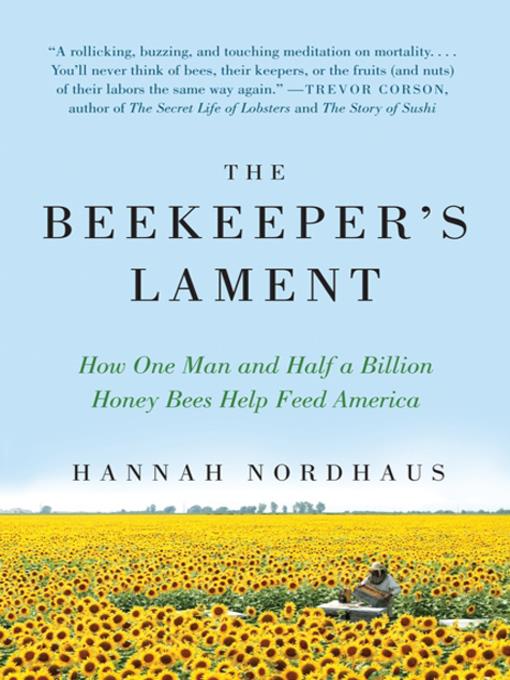
The Beekeeper's Lament
How One Man and Half a Billion Honey Bees Help Feed America
کتاب های مرتبط
- اطلاعات
- نقد و بررسی
- دیدگاه کاربران
نقد و بررسی

Starred review from March 14, 2011
In this revelatory, bittersweet investigation into the state of commercial beekeeping in the 21st century, Nordhaus follows the migratory life of a commercial beekeeper, John Miller, as he trucks his bees between California and North Dakota, pollinating almond orchards, defending his territory of "bee yards" (flowering pastures), collecting honey, and, against all odds, keeping his bees and his business alive. It turns out that colony collapse disorder, which recently brought awareness of bees and their essential agricultural function to an oblivious public, is only the most recent of numerous threats to bee health, from 19th-century plagues of wax moth comb invasion to more recent infestations of tracheal and varroa mites that "killed nearly every single one of the continent's feral colonies, obliterating the wild bees that once did much of the work pollinating the nations crops and flowers." According to Nordhaus, hives survive now only with drugs administered by their keepers, who, in a profession where disaster is commonplace and profit elusive, are becoming nearly as exotic and endangered as their bees. Miller, smart, antisocial with humans, but tender toward bees and prone to writing ironic free-verse e-mails, keeps the narrative lively despite its often grim content.

Starred review from April 15, 2011
A crackerjack story of one American beekeeper's days, with both his songs of joy and sorrow, presented within the context of beekeeping's natural and social history.
While researching a story about beekeeping, journalist Nordhaus happened upon John Miller, a migratory beekeeper who shuttles his thousands of hives from California to North Dakota. The author struck gold with the colorful Miller, a man who "likes to pontificate, joke, write, say incendiary things, tell stories, drip with sarcasm." As beekeeping has a fascinating, ages-old story to tell, Miller is an excellent ambassador, born to a long line of apiarists and a willing slave to his hives. Nordhaus is a lively writer who knows how to get to the nub of a topic, be it the architecture of a hive, the sting of a honey bee or the various nefarious infestations that beleaguer bee colonies. Since Colony Collapse Disorder has captured much national interest, she covers that plague, plus a host of other malefactors, such as mites and pesticides. Beekeeping has never been easy, but without the honeybees and their keepers, hundreds of crops would perish. The money in beekeeping, such as it is, is in the pollination fees, not the honey, and Nordhaus ably conveys the economics of the trade. She is just as able to describe the romance and miracle of honey, however. To make a pound, some 50,000 bees travel a collective 55,000 miles and visit more than two million flowers: "[B]ees carry the future from tree to tree, and honey is the reward for their labors, nectar distilled by desire and duty into something more."
A smooth-as-honey tour d'horizon of the raggedy world of beekeeping.
(COPYRIGHT (2011) KIRKUS REVIEWS/NIELSEN BUSINESS MEDIA, INC. ALL RIGHTS RESERVED.)

June 1, 2011
The 2006 bee colony collapse crisis generated several fine books on bees/beekeeping. This book differs by focusing on the keeper, not the kept. Meet John Miller, a fourth-generation migrant beekeeper, who trucks his hives to California and Washington State for winter pollination activities then back to North Dakota for summer foraging. It's a big outfit, one of the nation's top 20, and so much of its success rests on the health of Miller's millions of little employees. Readers will get a strong sense of what a crucial, beautiful, and terribly precarious livelihood beekeeping can be. The book's charm derives in large part from the author's rapport with her subject--they're kindred souls, journalist Nordhaus and Miller--both are appealingly self-effacing, and they seem to share (as the author points out) the occupational hazard of loneliness. VERDICT "Bee guy" Miller's lament is not of the weeping and wailing variety but rather a resigned, humorous, one-damn-thing-after-another approach to life. It's not too much of a stretch to suggest this book as a "do what you love" career guide. Or instead of that, it is highly recommended as both a character study and a compelling popular science work for interested readers.--Robert Eagan, Windsor P.L., Ont.
Copyright 2011 Library Journal, LLC Used with permission.

May 15, 2011
Migratory beekeeping is not a job found in a high-school guidance counselors files. And yet were it not for these roaming bee guys, some 1,200 strong in the U.S., there would be no almonds or blueberries or cranberries. Nearly $15 billion worth of crops every year depend on pollination, and only honey bees can perform up to the level required by agriculture and the demand of the nations consumers. Journalist Nordhaus follows beekeeper John Miller as he leaves his family for eight months each year, trucking thousands of hives and millions of bees from California (almonds) to Washington (apples) to North Dakota (wildflowers for honey) to Idaho (where the bees sleep for the winter in potato cellars). Miller has to contend not only with bee stingsone humorous part of the book provides the sting pain indexbut also a host of other problems. Miller is a complex and colorful man, and his story, along with the story of the bees, is an engaging read.(Reprinted with permission of Booklist, copyright 2011, American Library Association.)

























دیدگاه کاربران